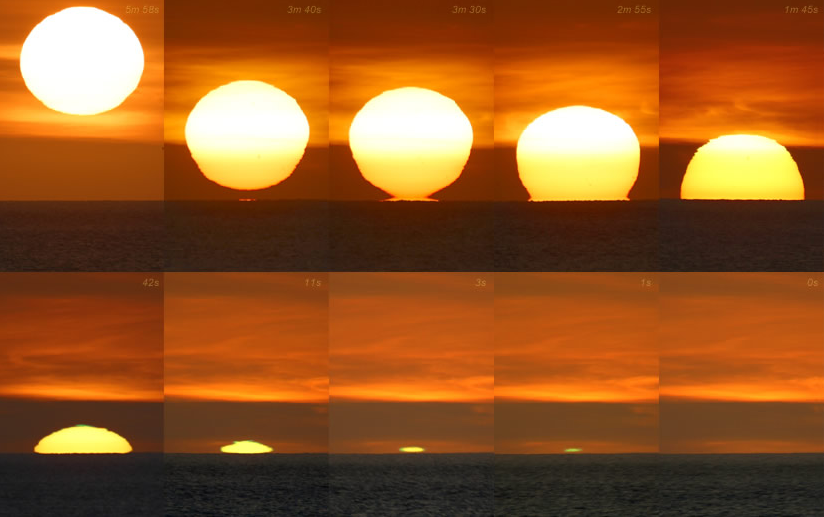Inferior Mirage Green Flash
Inferior Mirage Green Flash: Exploring the Phenomenon in Detail
Have you ever witnessed a breathtaking green flash just as the sun vanishes on the horizon? This awe-inspiring spectacle, known as the classical green flash, is made possible by a fascinating atmospheric phenomenon called an inferior mirage. In this article, we will delve into the intricate details of the inferior mirage green flash, shedding light on its formation and the conditions necessary for its occurrence.
The inferior mirage green flash relies on the presence of a mirage, which occurs when warm air hovers just above the ocean surface, creating a rapidly changing temperature profile with height. This temperature gradient causes the light to refract differently, magnifying the disparities between red and green light. As a result, a vivid glint of green becomes visible on the ocean horizon as the sun descends.
As the sun sets, the first indication of something extraordinary is a sliver of a "second sun" rising from the horizon, beneath the real sun. This lower sun is an inferior mirage, so named because its image appears below the actual sun. Over time, the lower sun merges with the upper sun, forming an enchanting Etruscan vase or omega shape. The two suns gradually overlap until they are nearly gone, creating a moment of maximum vertical magnification for the different paths of green and red rays. It is at this precise moment that the green flash bursts forth in all its glory.
The visibility of both the mirage and the green flash is influenced by your elevation above sea level. While the strongest Etruscan vase effects are observed close to the sea surface, you must be positioned above the warm air layer to witness the green flash. If you are too high above the surface, little or no green flash will be seen. Optimal viewing conditions may be achieved from dunes or elevated areas that are slightly lower than 10 meters in height.
To gauge the likelihood of witnessing a mirage and a green flash, one can examine the appearance of the horizon during the sunset sequence. If you observe peculiar tall and spiky "waves" on the horizon, rest assured that they are not real. Rather, they are the fluttery edges of the mirage, serving as a telltale sign that the sunset may be distorted and accompanied by a green flash at its culmination.
In conclusion, the inferior mirage green flash is a captivating atmospheric phenomenon that occurs when warm air above the ocean interacts with light, creating a magnified difference in refraction between red and green rays. By understanding the conditions necessary for its occurrence, such as a curved temperature profile and the observer's elevation, one can increase their chances of witnessing this extraordinary natural spectacle. So, keep your eyes peeled during sunset, and you might just be lucky enough to catch a glimpse of the elusive inferior mirage green flash.

The classical green flash, a brilliant glint of green almost on the ocean horizon just as the sun disappears, relies on a mirage to magnify the usually small differences in refraction between red and green light. The mirage occurs when there is warm air immediately over the ocean and the air temperature gradient changes rapidly with height, i.e. the temperature profile is curved. For the flash to be visible the warm air layers must be below you.
First indications of something unusual are when a sliver of a 'second sun' rises from the horizon as the 'real sun' descends. The lower sun is an inferior mirage (inferior because the image is below the real sun). As the sunset proceeds the lower sun eventually links with the upper sun to form an Etruscan vase or omega shape. The two suns overlap more and more. At the moment when the suns are almost gone the vertical magnification between the different paths of green and red rays is strongest. The green flash then shines forth.
The mirage and green flash are sensitive to your height above sea level. The strongest Etruscan vase effects are seen close to the sea surface but you must be above the warm air layer to see the flash, too high and little will be seen. The above sequence was from dunes 10m high but somewhere a little lower could be optimum.
The horizon appearance can hint at whether a mirage and green flash might be seen. Look at the horizon during the above sequence:

The peculiar tall and spiky 'waves' are not real. They are the fluttery edge of the mirage and a sign that the sunset could be distorted with a green flash at its end.
Note: this article has been automatically converted from the old site and may not appear as intended. You can find the original article here.
Reference Atmospheric Optics
If you use any of the definitions, information, or data presented on Atmospheric Optics, please copy the link or reference below to properly credit us as the reference source. Thank you!
-
<a href="https://atoptics.co.uk/blog/inferior-mirage-green-flash/">Inferior Mirage Green Flash</a>
-
"Inferior Mirage Green Flash". Atmospheric Optics. Accessed on November 21, 2024. https://atoptics.co.uk/blog/inferior-mirage-green-flash/.
-
"Inferior Mirage Green Flash". Atmospheric Optics, https://atoptics.co.uk/blog/inferior-mirage-green-flash/. Accessed 21 November, 2024
-
Inferior Mirage Green Flash. Atmospheric Optics. Retrieved from https://atoptics.co.uk/blog/inferior-mirage-green-flash/.